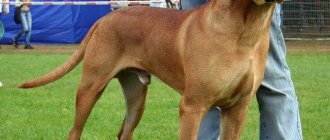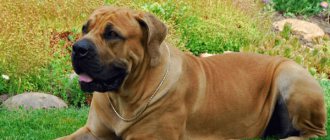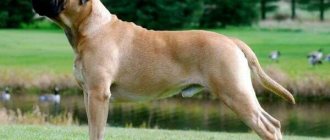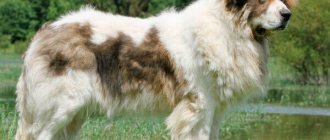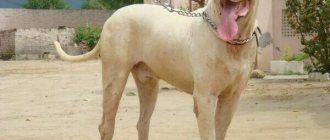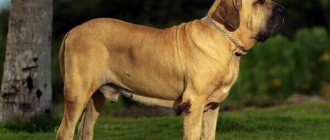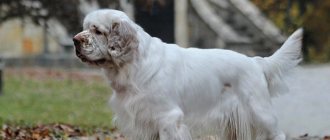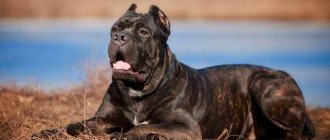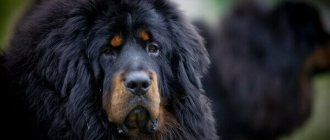The name "mastiffs" refers to a fairly large group of breeds, which includes Tibetan, English, French, Neapolitan, South African, American, Brazilian, Pakistani and other dogs with similar characteristics.
It took more than a hundred years to develop the Japanese Mastiff breed.
The result was a dog with clear fighting skills, capable of both hunting and home guarding.
These dogs, having a strong-willed character, recognize as masters only those who are able to cope with them.
But this does not make them worse, but on the contrary, they prove their superiority over other breeds.
Origin story
A hundred years ago, Japan was in great need of a fighting and hunting dog capable of teamwork . At that time, the Nihon Inu breed existed and was popular in this country.
They were used in hunting, but they did not obey their owner well, which was unacceptable.
At the same time, dog fighting was very popular in Japan . The Nihon Inu were much inferior to their opponents because they were much smaller and weaker. This hurt the honor of the samurai and the Japanese did not like it, because everyone wanted to win.
It was decided to create a breed through selection that would satisfy the needs of everyone. The Nihon Inu has been crossed with various Western breeds. It was a bulldog, bull terrier, mastiff, mastiff, pointer.
The result of such long work was the Tosa Inu breed, or Japanese mastiff . This dog was hardy, large and obedient.
Many years have proven that the Japanese Mastiff is not a family dog at all, but a fighting dog. The breed is still banned in some US states.
Where to buy Tosa Inu
Before you start looking for a breed, check the laws in your country. In some countries, including Australia, the UK, New Zealand, Norway, Denmark and others, ownership of tosa is either expressly prohibited or legally restricted.
Some states, cities, local governments, landowners and insurance companies also exclude tosa. In Japan, this breed is used for dog fighting, but in other parts of the world it is bred as a show dog and companion. The breed is rare, so finding a breeder can be difficult.
You can start your search for a dog at animal shelters to give a home to a lonely animal, or contact reputable breeders and buy a puppy with a proven health condition. They should not be released into a new home until they are at least eight weeks old and should also be vet checked.
Description of the breed
- This is a powerfully built dog with well-developed muscles and high withers;
- Height does not exceed 75 cm, weight – 60-70 kg;
- The stomach is tucked, the back is straight;
- The limbs are strong, with large round pads located on them;
- The neck is large, there is a fold on it;
- The head is wide and rectangular, with a clearly defined transition from the forehead to the muzzle;
- The ears are drooping and cannot be cropped;
- The nose is black, the eyes are dark shades, expressing calm and confidence;
- The mouth is powerful and strong, well developed;
- The tail is wide at the base, narrowing towards the end. Located high.
Choosing a puppy
The only Tosa Inu kennel Seii Taishougun is located in St. Petersburg. Only there you can buy a purebred pet that meets breed standards not only in appearance, but also in character. It is very dangerous to buy puppies secondhand. You can get not only an animal with a bunch of hereditary pathologies, but also an aggressive and uncontrollable one, which, alas, will become clear only with time.
Therefore, the pedigree will be the main document that the seller must provide. The price of a purebred puppy is about 30,000 rubles. You can also contact foreign nurseries, but taking into account transportation, the price will be higher.
A Tosa Inu puppy is the cutest creature, but it is at this age that you need to start training him
Character traits
Only a person of strong character, and certainly not a beginner, can properly raise a dog of this breed.
Mastiffs are neither stupid nor uncontrollable . On the contrary, they are distinguished by attentiveness, balance, intelligence and calmness.
But behind this there is also a great inner strength, which only a person equally strong internally can subjugate.
Leadership qualities are important when raising and training a mastiff..
The dog has developed protective potential. She will always stand up for the owner and those people who have earned her respect. He is quite wary of strangers, although without barking or aggression.
The dog senses the mood of people, so it does not tolerate falsehood and pretense . In a relationship with a mastiff, you need to be sincere and open, show your real intentions. This is the only way you can win the dog’s favor.
Hitting a mastiff is a bad decision . He will be angry with you, he will be afraid, and this is not respect. In this case, be prepared for the fact that at the decisive moment the dog will simply turn away from you.
Mastiffs do not like unfamiliar dogs or other pets in general. They will treat them with aggression only if they did not grow up together.
The dog is difficult to train, so it should be trained from an early age.
Expert opinion
Kozhevin Semyon Kirillovich
Expert dog handler.
“This dog is clearly not for the family or for interacting with small children. Mastiffs are proud and calm, but they definitely will not tolerate disrespect, and they perceive children as puppies, that is, they can bite and growl. If you have managed to earn the favor of a mastiff, he will respect and protect you to the death. These are extremely loyal dogs that will fight for their owner to the last.”
Japanese Chin
We should start the review with the most charming Japanese dog, which has long taken a place in the hearts of a large number of people. We are talking about the Japanese Chin. This little dog is so cute, active and playful that it simply has no equal among miniature pets. Only the Pekingese could compete with her, but his short legs and heavy landing simply do not allow him to catch up with the perky, self-confident and light little one.
The Japanese Chin is filled with a sense of self-importance and wants to be the center of everyone's attention, so it becomes very upset if its own attention is rejected. For more than 1000 years, chins belonged only to the imperial family, being royal favorites. One of the emperors even ordered them to be worshiped, declaring the dogs sacred. They had their own servants and doctors, and only members of the imperial family could own them. Especially miniature specimens were kept in cages, in a suspended state. A pair of Chins was given to Queen Victoria in 1853, which influenced the further development of the breed.
The Japanese Chin is unusually graceful, with a proud posture and luxurious coat. The coat color can be white with either black spots or red markings. The more distinct and brighter the red color, the better it is considered. The spots on the head and ears should be placed symmetrically relative to each other. Some believe that chins are descendants of a lion and a butterfly: they really look like a lion with their muzzles and are mobile, fluttering like butterflies.
Advantages and disadvantages
Advantages:
- Calmness and balance;
- A certain phlegmatic attitude towards others when everything is calm;
- Acute sense of smell and hearing;
- Quick response to what happened;
- Security and protective potential;
- Always comes to the owner's defense;
- Majestic appearance;
- Developed muscles.
Flaws:
- They are difficult to educate and train;
- If these aspects are delayed, the dog will grow up to be aggressive, controlled and antisocial;
- Not suitable for apartment;
- Not suitable for spending time with children;
- He has a strong character and obeys a person with authority, which in itself is not easy.
Sakhalin Husky
The Sakhalin Husky, called the Karafuto-Ken by the Japanese, is considered an endangered breed that survives today in small numbers only in Japan. It was once bred in Russia to transport goods, so the dog is strong, large and very independent. She has a calm character, good health and great stamina.
Although the husky first appeared in Russia, where it was called the Sakhalin Laika, the breed is currently under the patronage of Japan. Gone are the days when local tribes used it to bait bears, and today the Husky is a beautiful and balanced animal, very loyal to its owner. During the Second World War, these huskies were considered the best for military service on the eastern outskirts of the country.
How to properly care
Despite all the difficulties that you may encounter when raising a Mastiff, caring for a Mastiff is not that difficult . His short coat does not get particularly dirty; it is enough to brush it several times a week with a furminator.
If the dog gets very dirty while playing outside, then bathe him using special washing shampoos for dogs. However, this procedure should not be repeated more than once a month.
Mastiffs need to have their nails trimmed as they grow . But this task is not easy, because the Tosa Inu is far from a decorative dog. You need to be accustomed to this procedure from childhood, and if you are not confident in your abilities, then it is better to contact a groomer.
NOTE!
You need to wipe your eyes every morning and clean your ears at the end of each week.
You need to walk your mastiff every day, and these should be unusual walks . This breed requires constant physical activity, as well as constant honing of already acquired skills.
Tosa Inu is not suitable for an apartment . Such a dog should have a lot of space where it can run and frolic. This breed is also prone to colds, so damp rooms and low temperatures are not suitable for it.
Characteristics of the Tosa Inu
| Attachment level | Average |
| Friendliness | Short |
| Child friendly | Average |
| Loyalty to other pets | Short |
| Exercise needs | Average |
| Playfulness | Short |
| Energy level | Average |
| Learning ability | Average |
| Intelligence | Average |
| Tendency to bark | Short |
| Shedding amount | Short |
Nutritional Features
An adult dog needs to be fed twice a day . The diet must be nutritious and balanced for the dog to grow muscles. A veterinarian can help you create a menu.
He will describe the diet for the mastiff step by step. Natural nutrition is necessary if you plan to show your dog for fighting.
IMPORTANT!
If you don’t have much time to cook, and the dog performs the duties of a watchman and security guard, then you can feed him commercial food.
The main thing is that they are premium and super premium.
Ainu Dog or Hokkaido Dog
Hokkaido, or Ainu, Ainu-ken, Seta, Shita, also participated in the Second World War, but on the side of the Japanese. Used to transmit information and search for enemy camps. Like Shikoku, it was declared a Japanese natural monument in 1937. The ancestors of Ainu were dogs that participated with the Ainu tribes in hunting bears and other large animals.
Hokkaido have retained all their hunting animal instincts, which causes them to have a rather cruel disposition with a very cute appearance. Ainu does not tolerate other animals and strangers, and in addition, he constantly fights for power with anyone who claims it. Therefore, keeping such animals in a city apartment or large family is not recommended.
Other breeds worth mentioning include the Japanese Spitz, Japanese Terrier, Ryukyu, Jomon Shiba, Shiba Inu and Tosa Inu. But we can talk about them next time.
How to choose?
When choosing a mastiff puppy, you should contact a nursery where breeders have already raised this breed.
He needs to be tested, because fighting dogs are no joke:
- The puppy must already be 2 months old;
- It should be of medium size without any developmental defects in the jaw, tail joints, eyes and ears;
- Six should be bright, without bald spots;
- A healthy puppy's belly is soft and free of lumps;
- The baby should not be too thin, but not too fat either;
- The normal temperament for a Japanese Mastiff puppy is curiosity, playfulness, and lack of cowardice and aggression.
General health problems
Like all purebred dogs, Tosas can be prone to developing certain genetic diseases. Responsible breeders test their adult Toshi before breeding to ensure they do not transmit unwanted diseases such as hip and elbow dysplasia.
Like many large, deep-chested breeds, the Tosa may be at high risk of developing bloat, a life-threatening condition when the stomach fills with air and flips over.
Mating
You can knit Tosa Inu from 24-30 months. It is at this time that the maturation cycle ends, and the dog becomes capable of not only conceiving, but also bearing healthy offspring. Despite the fact that the first heat begins at 8-10 months, the girl is physically unable to give birth to healthy, strong puppies. Females who have given birth are recommended to withstand 1-2 heats before the next pregnancy.
The owner of the female needs to monitor the cycles in order to contact the kennel club before estrus to find a suitable male. This will allow you to choose the ideal candidate who will complement the girl’s shortcomings. In addition, the born puppies will receive status and will be included in the breed book (provided that both mom and dad have a pedigree).
Read a detailed article on the topic: “Everything you need to know about breeding dogs: appropriate age, what to do if it doesn’t work out, rules and tips.”
Owners need to fill out certificates and documentation, agree on the time and place of mating. The date can be determined based on the fact that the cell in the uterus matures approximately 13-15 days from the start of estrus. It is then that the bitch becomes playful, her loop softens, and the discharge becomes a light translucent color.
Animals are brought to the male dog’s territory or to a neutral place where the male will feel relaxed and the female submissive . Experienced girls know when to let a guy in. The dogs will get acquainted, the boy will try to do the cage. An untied male knits on his own and rarely needs help.
Repeated mating is scheduled after 48 hours. Pregnancy can be accurately diagnosed in the 3rd week. On average, in large dogs it lasts 50-60 days.
Shikoku
An ancient Japanese breed in origin is the closest relative of the Shiba Inu. Adult dogs grow over 50 cm at the withers, with short, dense hair that requires almost no grooming. Shikoku can be kept in an apartment, but then they need to be walked regularly, because by nature they are active and agile hunters.
Photo: funart.pro
Owner reviews
“My wife and I were choosing a dog, we wanted a big one because we were moving out of town and could afford it. Attention fell on the Japanese mastiff, but after reading the description they were horrified. It was written everywhere that pets are very difficult, that you need to spend a lot of time on them, etc.
But when we came to see the puppy, we immediately fell in love and forgot about everything we had read. And guess what? We have never regretted our choice . Calm, kind, gentle Theo became our favorite, watchman and family member. The children love him, and he loves them. He has never shown aggression, but is very attentive to the behavior of others.”
“Our Curry is simply the embodiment of beauty and grace. Our four-legged samurai. We bought a puppy, and a friend later said that she had heard negative reviews about the breed. Nothing like this. We are delighted, because this is support, a guard, a friend, family, and a warm bag of love!”
Walks
The Japanese dog, as a representative of the giant breed, needs sufficient physical activity, which can be provided by walking the pet for more than 2 hours a day. Being in a confined space and lack of exercise has a negative impact on the dog's health.
Rules for walking a Japanese Mastiff:
- sufficient walking time;
- active games on the street;
- regular “loading” of the intellect with exercises;
- harness so as not to injure the dog’s weak cervical vertebrae.
Feeding
The diet of the Tosa Inu should be selected by a professional. The reason is that their stomachs and muscles need a strictly defined set of nutrients. The best option is to contact a qualified veterinarian and dog trainer to help you choose your daily diet.
If this is not possible, you can try several high-quality dry foods and see which one your dog reacts to best. You can read reviews about a product to know about its features, pros and cons. As a result, dry food can save a dog owner a lot of time and effort. Just don’t forget about regular checkups with a veterinarian to protect yourself from the negative consequences of long-term use.
Table: deviations from breed standards and grounds for disqualification
Japanese Spitz: description of the breed, size, character
In order to distinguish a purebred dog, you need to know the breed standards. They are described in the table:
| Body | Weak muscles |
| Backbone | Thin |
| Mouth bite | Undershot or overshot |
| Character | Aggressiveness, cowardice, timidity |
| Muzzle | Tapered |
| Head | Narrow skull |
| Genitals | Underdeveloped testes that are not descended into the scrotum |
Any deviations from the FCI standard No. 260 dated December 9, 1997 are considered a defect in the breed and are not allowed for breeding.
Japanese Spitz
Japanese Spitz belong to the young Japanese breeds and trace their history back to the twenties of the last century. This breed was bred artificially by breeders, but it is not yet possible to reliably identify all the “participants” who took part in the creation of the Japanese Spitz. It is generally accepted that they were dwarf Spitz dogs or Samoyed huskies. Later, the ancestors of the breed were joined by German Spitz and Eske.
Japanese Spitz
In the process of recognizing the breed, Japanese Spitz faced a number of difficulties. And if the International Canine Association and the English Club quickly accepted the breed, the American Club even today refuses to assign the “Japanese” the status of a separate breed due to its similarity with the American Spitz.
Character traits
Since the Japanese Spitz is not a native breed used for hunting, it is completely pointless to expect hunter qualities from it. The main character traits of the breed are:
- agreeableness. Japanese Spitz quickly get along with their owners and rarely insist on their dominant position, competing for leader status;
Japanese Spitz dogs are very easy to handle and are well suited for beginners.
- restraint. A specific feature of Japanese breeds is their taciturnity. Japanese Spitz know the value of a word, and will not bark without a reason;
- activity. The need for frequent walks and an active lifestyle remains characteristic of Japanese Spitz dogs into old age. They are designed for a busy life and are not suitable for owners who prefer jogging to sitting in a chair with a book;
- touchiness. Japanese Spitz dogs expect an equal relationship from their owner. Any attempts to rudely put your pet in his place will lead to a sharp protest reaction on his part.
Japanese Spitz dogs want to see a caring and sensitive friend in their owner.
Color
All Japanese Spitz have a distinctive snow-white coat. The presence of any inclusions or spots is a serious fault in the breed, often leading to disqualification of individuals. You can read below about how to properly care for the silky coat of representatives of the breed.
Bathing a Japanese Spitz
